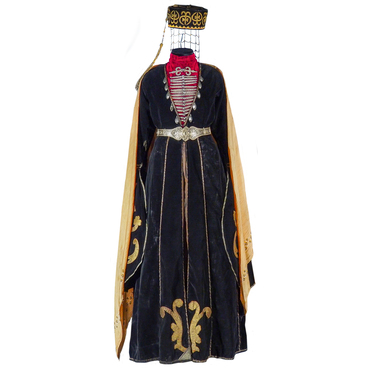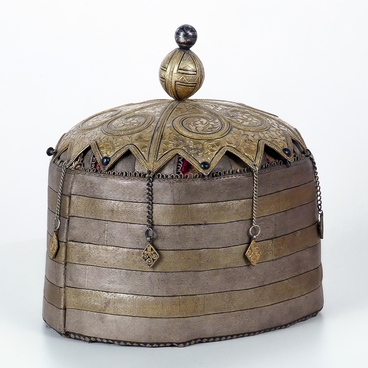Elegant bonnets of different designs, decorated with gold sewing, were the Adyghe girls’ main headwear. In the exhibition, you can see a cone-shaped bonnet that reminds a man’s helmet. Such bonnets were always worn with a scarf. The scarf was either placed over the bonnet to cover the shoulders and the back, leaving its ends at the front, or attached to a ball at the top of the bonnet so that it hang down along the back. An Adyghe girl could also cross the ends of the scarf under her chin and fix them at the top of the bonnet.
All the Adyghe bonnets, regardless of their design, were made on a hard base in order to maintain their clear-cut shape. The lining was made from leather or fabric, and the base was usually covered with a galloon. The technique of creating a galloon is considered the first weaving technique that appeared in the European continent. The Adyghe women were very skillful at that. To make the precious band, they used fine wooden rectangular boards 6-8 cm in size. At the corners of each board, 4 to 6 holes were made. Through them, the artisans threaded golden threads of two different shades to make the ornament. The beauty of those ornaments depended on the complexity of weaving of the threads. The part of the galloon that was already finished was wound on a metallic hook attached to the belt.
The bonnet here is decorated with the so-called town or bazaar hemstitch. The Adyghes started to decorate their clothes with such embroidery in the 19th – beginning of the 20th century, although it appeared much earlier. The ornament in this technique was made according to a template drawn beforehand and fixed to the fabric with golden or silver threads and fixed with silk at the borders.
The hemstitch was mostly used for elements of ceremonial outfit, so the ornaments were chosen with great care. Initially, they included elements of the surrounding landscape, but they gradually became more and more schematic, until their elements turned into lines and shapes: horn-like ringlets, circles, crosses and others. The researchers note that those symbols originate from the cult of the Sun, and the Circassiands believed that objects decorated by them were a kind of talismans. That is why not only women’s dresses were decorated with elements of gold sewing, but also men’s felt cloaks, saddles and quivers.
All the Adyghe bonnets, regardless of their design, were made on a hard base in order to maintain their clear-cut shape. The lining was made from leather or fabric, and the base was usually covered with a galloon. The technique of creating a galloon is considered the first weaving technique that appeared in the European continent. The Adyghe women were very skillful at that. To make the precious band, they used fine wooden rectangular boards 6-8 cm in size. At the corners of each board, 4 to 6 holes were made. Through them, the artisans threaded golden threads of two different shades to make the ornament. The beauty of those ornaments depended on the complexity of weaving of the threads. The part of the galloon that was already finished was wound on a metallic hook attached to the belt.
The bonnet here is decorated with the so-called town or bazaar hemstitch. The Adyghes started to decorate their clothes with such embroidery in the 19th – beginning of the 20th century, although it appeared much earlier. The ornament in this technique was made according to a template drawn beforehand and fixed to the fabric with golden or silver threads and fixed with silk at the borders.
The hemstitch was mostly used for elements of ceremonial outfit, so the ornaments were chosen with great care. Initially, they included elements of the surrounding landscape, but they gradually became more and more schematic, until their elements turned into lines and shapes: horn-like ringlets, circles, crosses and others. The researchers note that those symbols originate from the cult of the Sun, and the Circassiands believed that objects decorated by them were a kind of talismans. That is why not only women’s dresses were decorated with elements of gold sewing, but also men’s felt cloaks, saddles and quivers.



